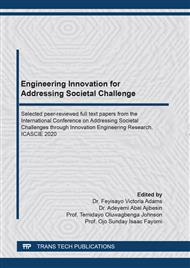[1]
C H Aginam, C A Chidolue, C Nwakire, Investigating the effects of coarse aggregate types on the compressive strength of concrete. Int. J.l of Eng.Res.and Appl., 3(1): (2013) 1140-1144.
Google Scholar
[2]
Neville, A M & Brooks, J J 2007. Properties of concrete, Fourth edition, Prentice Hall: Pearson Education Limited.
Google Scholar
[3]
O.O Adebayo, P.K Fakunle, A.B. Odeniyan,. The effect of aggregate type on the strength of concrete. Unpublished Thesis. Department of Civil Engineering, University of Lagos, Nigeria. (2001).
Google Scholar
[4]
A.A Raheem, O.M Aderonmu. The effect of aggregate sizes on the strength of concrete. J. of Sci., Eng. and Tech. (JSET), 9(2): (2002) 4041-4051.
Google Scholar
[5]
BS 812-103.1 1985. Testing aggregates. Method for determination of particle size distribution. Sieve Tests. London: British Standard Institution.
Google Scholar
[6]
BS 812-2 1995. Testing aggregates. Methods for determination of density. London: British Standard Institution.
Google Scholar
[7]
BS 812-109 1990. Testing aggregates. Methods for determination of moisture content. London: British Standard Institution.
Google Scholar
[8]
BS 812-110 1990. Testing aggregates. Methods for determination of aggregate crushing value (ACV). London: British Standard Institution.
DOI: 10.3403/00218276
Google Scholar
[9]
BS 812-112 1990. Testing aggregates. Method for determination of aggregate impact value (AIV). London: British Standard Institution.
Google Scholar
[10]
BS 1881: Part 102 1983. Testing concrete, Method for determination of slump. London: British Standards Institution.
Google Scholar
[11]
BS 1881: Part 103 1983. Testing concrete, Method for determination of compacting factor. London: British Standards Institution.
Google Scholar
[12]
BS 1881: Part 116 1983. Testing concrete, Method of determination of compressive strength of concrete cubes. London: British Standards Institution.
Google Scholar
[13]
BS 1881: Part 117 1983. Testing concrete, Method of determination of tensile splitting strength. London: British Standards Institution.
Google Scholar
[14]
D.A. Adesanya, A.A Raheem 2010. A Study of the permeability and acid attack of corn cob ash blended cement. Cons. and Build. Mat.s, 24 (2010) 403-409.
DOI: 10.1016/j.conbuildmat.2009.02.001
Google Scholar
[15]
J S Bowles Engineering Properties of Soil and Their Measurement, 4th edition. New York: McGraw Hill (1992.).
Google Scholar
[16]
ASTM (American Society for Testing and Materials) 1994. Specifications for fineness modulus, ASTM C 125, USA: West Conshohocken, PA.
Google Scholar
[17]
ASTM (American Society for Testing and Materials) 2005. Specific gravity and absorption of coarse/fine aggregate, ASTM C127/128, ASTM International, USA: West Conshohocken, PA.
DOI: 10.1002/ep.670180104
Google Scholar
[18]
I A R G Van de Wall, J,S. Ajalu, 1997. Characterization of the geotechnical properties of rock material for construction purposes. Int. J. Rock Mech. & Min. Sci., 34(3-4): (1997).
DOI: 10.1016/s1365-1609(97)00208-6
Google Scholar
[19]
BSI (British Standard Institution) 1997. Structural use of concrete: code of practice for Design and construction. BS8110: Part 1, London: British Standard Institution.
Google Scholar


